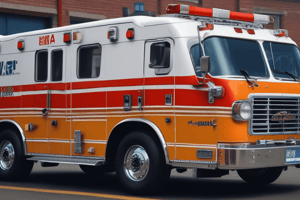Podcast
Questions and Answers
What is one of the core competencies tested in the cognitive component of the AEMT test?
What is one of the core competencies tested in the cognitive component of the AEMT test?
- Phlebotomy procedures
- Firefighting techniques
- Patient assessment (correct)
- Vehicle maintenance
Which component of the AEMT test involves identifying and treating physical injuries from accidents or violence?
Which component of the AEMT test involves identifying and treating physical injuries from accidents or violence?
- Medical emergencies evaluation
- Pharmacology assessment
- Airway management examination
- Trauma management assessment (correct)
What does the cognitive component of the AEMT test assess according to the text?
What does the cognitive component of the AEMT test assess according to the text?
- Biotechnology applications
- Understanding of pharmacology (correct)
- Surgical techniques
- Chemical engineering principles
In the AEMT test, what is included as part of trauma management?
In the AEMT test, what is included as part of trauma management?
Which of the following is NOT part of the cognitive component of the AEMT test?
Which of the following is NOT part of the cognitive component of the AEMT test?
A patient is experiencing difficulty breathing due to an obstructed airway. Which of the following techniques should an AEMT employ first?
A patient is experiencing difficulty breathing due to an obstructed airway. Which of the following techniques should an AEMT employ first?
A patient has sustained a traumatic injury and is exhibiting signs of internal bleeding. What is the most appropriate initial action for an AEMT?
A patient has sustained a traumatic injury and is exhibiting signs of internal bleeding. What is the most appropriate initial action for an AEMT?
An elderly patient with a history of heart disease is experiencing chest pain and shortness of breath. Which of the following medications would be appropriate for an AEMT to administer?
An elderly patient with a history of heart disease is experiencing chest pain and shortness of breath. Which of the following medications would be appropriate for an AEMT to administer?
A patient is experiencing an anaphylactic reaction with severe respiratory distress. Which of the following medications should an AEMT administer?
A patient is experiencing an anaphylactic reaction with severe respiratory distress. Which of the following medications should an AEMT administer?
A patient has sustained a traumatic injury to the abdomen and is exhibiting signs of internal bleeding. What is the most appropriate action for an AEMT?
A patient has sustained a traumatic injury to the abdomen and is exhibiting signs of internal bleeding. What is the most appropriate action for an AEMT?
Flashcards are hidden until you start studying
Study Notes
Advanced Emergency Medical Technician (AEMT) Test
The Advanced Emergency Medical Technician (AEMT) test is a comprehensive evaluation that measures the candidate's competence in providing advanced emergency medical care. The test aims to ensure that AEMTs possess the necessary skills and knowledge to handle various medical and trauma scenarios. The AEMT test comprises two main sections: a cognitive component and a psychomotor component.
Cognitive Component
The cognitive component of the AEMT test assesses the candidate's understanding of various aspects of emergency medical care, including patient assessment, trauma management, medical emergencies, airway management, and pharmacology. The exam consists of multiple-choice questions covering these topics, and the candidate has a set amount of time to complete the section. The passing score for the cognitive component is typically set at 70% or above.
Patient Assessment
Patient assessment is one of the core competencies tested in the cognitive component. AEMTs are expected to evaluate patients through various methods, identify potential issues, and prioritize treatment based on the severity of the situation. They should understand how to approach both medical and trauma patients, considering factors like age, location, and environmental conditions.
Trauma Management
Trauma management involves identifying and treating patients who have suffered physical injuries due to accidents, violence, or other causes. AEMTs must be able to assess patients for signs of internal damage, monitor vital signs, and provide appropriate first aid until the arrival of more advanced medical support.
Medical Emergencies
Medical emergencies refer to situations where patients require immediate attention for illnesses or complications arising from chronic health conditions. AEMTs need to recognize common medical problems, understand when to call for backup, and know how to administer specific treatments while waiting for further assistance.
Airway Management
Airway management is crucial in cases where patients experience breathing difficulties or are unable to breathe properly due to various reasons such as trauma, illness, or anaphylaxis. AEMTs should be adept at performing proper airway management techniques and utilizing appropriate tools, such as supraglottic airways and dual lumen airway devices.
Pharmacology
Pharmacology is another key aspect of the AEMT test. Candidates must demonstrate a thorough understanding of various medications, their uses, side effects, contraindications, and potential interactions. They should also be skilled in calculating dosages, selecting appropriate delivery methods, and monitoring patients for adverse reactions.
Psychomotor Component
The psychomotor component of the AEMT test evaluates the candidate's practical skills in emergency medical care. It consists of several stations, each focusing on a specific area, such as patient assessment and management, cardiac arrest management, airway management, intravenous therapy, and medication administration. The candidate is required to perform specific tasks within a defined time frame, demonstrating proficiency and competence in real-life scenarios.
Studying That Suits You
Use AI to generate personalized quizzes and flashcards to suit your learning preferences.




